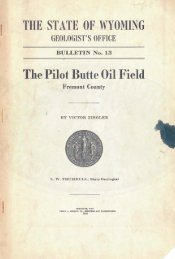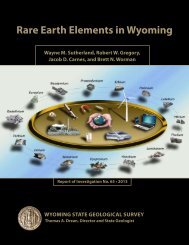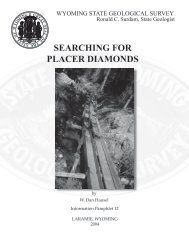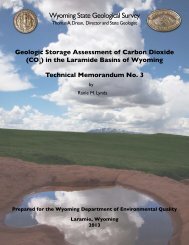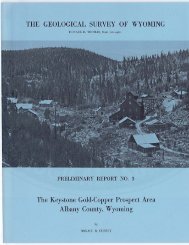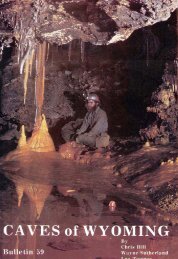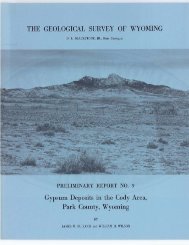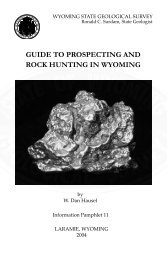The Dinosaurs of Wyoming - Wyoming State Geological Survey ...
The Dinosaurs of Wyoming - Wyoming State Geological Survey ...
The Dinosaurs of Wyoming - Wyoming State Geological Survey ...
You also want an ePaper? Increase the reach of your titles
YUMPU automatically turns print PDFs into web optimized ePapers that Google loves.
112 THE DINOSAURS OF WYOMING<br />
smaller Mesozoic mammals that J. B. Hatcher collected<br />
from the tops <strong>of</strong> ant heaps, commonly found in sandy areas.<br />
If no ant heaps were present Mr. Hatcher would moye an ant<br />
colony with a shovel, returning months later to gather the<br />
minute fossils brought to the surface by the indefatigable insects.<br />
As flesh and blood animals these Cretaceous mammals<br />
were tiny, mouse-like in size. <strong>The</strong>re is an idea occasionally<br />
expressed that these small mammals hastened the extinction<br />
<strong>of</strong> the dinosaurs by feeding on the reptilian eggs. We do not<br />
know, however, whether or not all <strong>Dinosaurs</strong> laid eggs, and<br />
it is probable that the Upper Cretaceous mammals did not<br />
live in the same region. <strong>The</strong>se mammals were eaters <strong>of</strong> roots<br />
and other vegetation, eaters <strong>of</strong> insects, eaters <strong>of</strong> fruits, seeds,<br />
and some were omnivorous. Some <strong>of</strong> them lived in trees, in<br />
holes in the ground and among the rocks. Simpson says:<br />
"<strong>The</strong> Mesozoic mammals constituted a little world <strong>of</strong> their<br />
own. In their society were all the fundamental adaptive types<br />
<strong>of</strong> a recent mammalian fauna. Some were chiefly insectivorous,<br />
others predaceous, while still others were herbivorous. It is<br />
the latter, the Multituberculata, which ... were the most successful<br />
<strong>of</strong> Mesozoic mammals, for, appearing as early as the<br />
very first, they occur at every mammal-bearing horizon in the<br />
Mesozoic and even linger into the beginning <strong>of</strong> the age <strong>of</strong> mammalian<br />
dominance without any remarkable change. <strong>The</strong>y undoubtedly<br />
owed this longevity to their complete and successful<br />
adaptation, and also to the fact that they alone among Mesozoic<br />
mammals did not have to face heavy reptilian competition<br />
for food, as did the small insectivores and carnivores. \\<strong>The</strong>n<br />
the more progressive plant-eating mammals <strong>of</strong> the Paleocene<br />
appeared, the days <strong>of</strong> the Multituberculates \,"ere numbered.<br />
Yet, so perfect was their adaptation, even then they lingered<br />
on until the very moment when the Paleocene herbivores were<br />
themselves doomed by the invasion <strong>of</strong> the modernized mammals,<br />
beginning in the earliest true Eocene."




